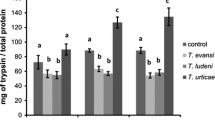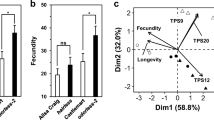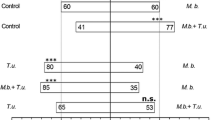Abstract
The aim of this work was to study how nitrogen availability affects within-plant allocation to growth and secondary metabolites and how this allocation affects host selection by herbivores. Tomato plants (Lycopersicon esculentum) were grown at six levels of nitrogen availability. When nitrogen availability increased, plant relative growth rate increased, but tissue carbon/nitrogen ratio in the second oldest true leaf and allocation to large glandular trichomes (type VI) as well as to the defense compounds rutin and chlorogenic acid decreased. Leaf protein concentration increased. Two-spotted spider mite (Tetranychus urticae) females responded significantly to these changes: in dual choice tests they preferred leaf disks from plants grown at high nitrogen availability, with a low C/N ratio. This preference persisted in an olfactometer in which the mites were offered only the odors released by leaves with damaged trichomes. We conclude that in a tomato leaf increased nitrogen availability leads to decreased allocation to defenses, and that repellent volatiles released by trichomes play a key role in affecting leaf selection by two-spotted spider mite females.
Similar content being viewed by others
REFERENCES
Aina, O. J., Rodriguez, J. G., and Knavel D. E. 1972. Characterizing resistance to Tetranycus urticae in tomato. J. Econ. Entomol. 65:641–643.
Al Rouz, H., and Thibout, E. 1988. Analyse en olfactomètre de l'attraction des larves d'Acrolepiopsis assectella par des substances allélochimiques. Entomol. Exp. Appl. 47:231–237.
Bryant, J. P., Chapin, F. S., and Klein, D. R. 1983. Carbon /nutrient balance of boreal plants in relation to vertebrate herbivory. Oikos 40:357–368.
Buttery, R. G., Ling, L. C., and Light, D. M. 1987. Tomato leaf volatile aroma components. J. Agric. Food. Chem. 35:1039.
Chatzivasileiadis, E. A., and Sabelis, M. A. 1997. Toxicity of methyl ketones from tomato trichomes to Tetranychus urticae Koch. Exp. Appl. Acarol. 21:473–484.
Cook, S. P. 1992. Influence of monoterpene vapors on spruce spider mite, Oligonychus ununguis, adult females. J. Chem. Ecol. 18:1497–1504.
Dicke, M., Takabayashi, J., Posthumus, M. A., SchÜtte, C., and Krips, O. E. 1998. Plant-phytoseiid interactions mediated by herbivore-induced plant volatiles: Variation in production of cues and in responses of predatory mites. Exp. Appl. Acarol. 22:311–333.
Dormont, L., Roques, A., and Malosse, C. 1997. Efficiency of spraying mountain pine cones with oleoresin of Swiss stone pine cones to prevent insect attack. J. Chem. Ecol. 23:2262–2274.
Elliger, C. A., Wong, Y., Chan, B. G., and Waiss, A. C. 1981. Growth inhibitors in tomato (Lycopersicon) to tomato fruitworm (Heliothis zea). J. Chem. Ecol. 7:753–758.
Farrar, R. R., and Kennedy, G. G. 1991. Insect and mite resistance in tomato, pp. 121–142, in G. Kalloo (ed.). Genetic Improvement of Tomato. Springer-Verlag, Berlin.
Gentile, A. G., Webb, R. E., and Stoner, A. K. 1969. Lycopersicon and Solanum spp. resistant to the carmine and the two-spotted spider mite. J. Econ. Entomol. 62:834–836.
Grostal, P., and Dicke, M. 1999. Direct and indirect cues of predator risk influence behavior and reproduction of prey: A case for acarine interactions. Behav. Ecol. 10:422–427.
Hanna, M. A., Zaher, M. A., and Ibrahim, S. M. 1982. Some probable causes of host preference in six species of phytophagous mites. Z. Angew. Entomol. 93:329–333.
Herms, D. A., and Mattson, W. J. 1992. The dilemma of plants: To grow or to defend. Q. Rev. Biol. 67:283–335.
Hoffland, E., Van Beusichem, M. L., and Jeger, M. J. 1999. Nitrogen availability and susceptibility of tomato leaves to Botrytis cinerea. Plant Soil 210:263–272.
Ingestad, T., and Lund, A. B. 1979. Nitrogen stress in birch seedlings. I. Growth technique and growth. Physiol. Plant45:137–148.
Isman, M. B., and Duffey, S. S. 1982. Toxicity of tomato phenolic compounds to the fruitworm, Heliothis zea. Entomol. Exp. Appl. 31:370–376.
Jansen, M. P. T., and Stamp, N. E. 1997. Effects of light availability on host plant chemistry and the consequences for behavior and growth of an insect herbivore. Entomol. Exp. Appl. 82:319–333.
Jones, C. G., Hare, J. D., and Compton, S. J. 1989. Measuring plant protein with the Bradford assay. 1. Evaluation and standard method. J. Chem. Ecol. 15:979–991.
Kielkiewicz, M. 1994. The appearance of phenolics in tomato leaf tissue exposed to spider mite attack. Acta Hortic. 381:687–690.
Kriesch, S., and Dicke, M. 1997. Avoidance of predatory mites by the two-spotted spider mite Tetranychus urticae: The role of infochemicals. Proc. Sect. Exp. Appl. Entomol. Neth. Entomol. Soc. 8:121–126.
Loomis, W. E. 1932. Growth-differentiation balance vs. carbohydrate-nitrogen ratio. Proc. Am. Soc. Hortic. Sci. 29:240–245.
Luckwill, L. C. 1943. The Genus Lycopersicon: An Historical, Biological, and Taxonomic Survey of the Wild and Cultivated Tomatoes. The University Press, Aberdeen.
Mattson, W. J. 1980. Herbivory in relation to plant nitrogen content. Annu. Rev. Ecol. Syst. 11:119–161.
McNeill, S., and Southwood, T. R. E. 1978. The role of nitrogen in the development of insect /plant relationships, pp. 77–98, in J. B. Harborne (ed.). Biochemical Aspects of Plant and Animal Coevolution. Academic Press, London.
Pella, E., and Colombo, B. 1973. Study of carbon, hydrogen and nitrogen determination by combustion-gas chromatography. Mikrochim. Acta 1973:697–719.
Rasmy, A. H. 1985. The biology of the two-spotted spider mite Tetranychus urticae as affected by solanaceous plants. Agric. Ecosyst. Environ. 13:325–328.
Ridsdill-Smith, T. J., Jiang, Y., and Ghisalberti, E. L. 1995. A method to test compounds for feeding deterrence towards redlegged earth mite (Acarina: Penthaleidae). Ann. Appl. Biol. 127:593–600.
Snyder, J. C., and Carter, C. D. 1985. Trichomes on leaves of Lycopersicon hirsutum, L. esculentum and their hybrids. Euphytica 34:53–64.
Stamp, N. E., and Yang, Y. 1996. Response of insect herbivores to multiple allelochemicals under different thermal regimes. Ecology 77:1088–1102.
Takabayashi, J., and Dicke, M. 1992. Response of predatory mites with different rearing histories to volatiles of uninfested plants. Entomol. Exp. Appl. 64:187–193.
Tomczyk, A., and KropczyÑska, D. 1985. Effects on the host plant, pp. 317–329, in W. Helle and M. W. Sabelis (eds.). Spider Mites, Their Biology, Natural Enemies and Control. Elsevier, Amsterdam.
Tulisalo, U. 1971. Free and bound amino acids of three host plant species and various fertilizer treatments affecting the fecundity of the two-spotted spider mite, Tetranychus urticae Koch (Acarina, Tetranychidae). Ann. Entomol. Fenn. 37:155–163.
Van Haren, R. J. F., Steenhuis, M. M., Sabelis, M. W., and De Ponti, O. M. B. 1987. Tomato stem trichomes and dispersal success of Phytoseiulus persimilis relative to its prey Tetranychus urticae. Exp. Appl. Acarol. 3:115–121.
Weston, P. A., Johnson, D. A., Burton, H. T., and Snyder, J. C. 1989. Trichome secretion composition, trichome densities, and spider mite resistance of ten accessions of Lycopersicon hirsutum. J. Am. Soc. Hortic. Sci. 114:492–498.
Wilkens, R. T., Shea, G. O., Halbreich, S., and Stamp, N. E. 1996a. Resource availability and the trichome defenses of tomato plants. Oecologia 106:181–191.
Wilkens, R. T., Spoerke, J. M., and Stamp, N. E. 1996b. Differential responses of growth and two soluble phenolics of tomato to resource availability. Ecology 77:247–258.
Author information
Authors and Affiliations
Rights and permissions
About this article
Cite this article
Hoffland, E., Dicke, M., Van Tintelen, W. et al. Nitrogen Availability and Defense of Tomato Against Two-spotted Spider Mite. J Chem Ecol 26, 2697–2711 (2000). https://doi.org/10.1023/A:1026477423988
Issue Date:
DOI: https://doi.org/10.1023/A:1026477423988




